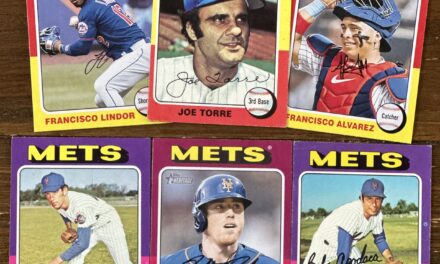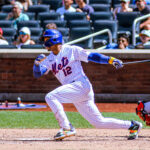
The New York Mets accomplished quite a bit in 1999 as a squad. Manager Bobby Valentine watched his club post a 97-66 record, clinching a National League wild-card berth and the organization’s first trip to the playoffs since 1988. Unfortunately, they couldn’t dig themselves out of an early hole against the Atlanta Braves in the NLCS, ultimately falling in six games.
That series-ending based-loaded walk given up by Kenny Rogers still haunts me.
While the Mets returned to the postseason the following year to avenge that loss and at least take home the NL pennant, it’s hard to argue just how good that ’99 squad was, especially when looking at the position players. With a cumulative fWAR of 29.7, New York ranked as the third-best unit in baseball, while its collective 105 wRC+ was also a top-10 mark.
There were a number of factors that led to those results — Rickey Henderson had one last dynamic season as a leadoff hitter and Roger Cedeno used his speed to swipe a then-club-record 66 bases. What really jumped out at me, though, was exactly how dynamic the middle of the Mets’ order was. I’d usually limit the “middle of the order” to the three, four, and five sports, but there were so many terrific individual performances that I have to include the two-hole, as well.
Thanks to Baseball-Reference, we can see that the most common combination of players penciled into these spots by Valentine were as follows: Edgardo Alfonzo (146), John Olerud (159), Mike Piazza (136), and Robin Ventura (124). We know Olerud’s best overall season as a Met came in 1998, but the year that followed wasn’t too shabby, either. By way of fWAR, three of the above four hitters finished the year among the top 20 players in baseball, with Piazza being the only one finishing on the outside.
Just look at how dynamic this group was on offense by looking at their season-long statistics:

Mets position players posted a cumulative fWAR of 29.7 in 1999. These four players accounted for nearly 80.0% of that by accumulating 23.5 all by themselves.
What struck me about these stats when putting them side by side is how consistent they look across the board. Only Olerud failed to post at least 20 home runs and 100-plus RBI, and he was damn close to doing so. None of them posted an OPS lower than .885 or a wRC+ lower than 125, and for the power numbers produced here, the walk and strikeout rates are eerily close to one another.
From the vantage point of fWAR and wRC+, the 1999 campaign wasn’t the best overall performance of the Mets careers for either Piazza or Alfonzo. But from the vantage point of counting stats like home runs and RBI (let’s throw in runs scored, too), it was the best output they would end up having during a single season in Flushing.
As for Ventura, that 7.3 fWAR was the best single-season performance of his entire career, which also placed him fourth in baseball. Only Jeff Bagwell (7.8), Manny Ramirez (7.5), and Derek Jeter (7.4) finished ahead of him. Ventura also added a Gold Glove award to a campaign that landed him sixth in NL MVP voting, the only time he finished in the top-10 during his career.
In fact, the top-10 vote getters had a heavy Queens influence. Nobody finished in the top five, but Ventura, Piazza, and Alfonzo finished sixth, seventh, and eighth, respectively.
Who knows what could’ve happened if New York had resisted from falling into a treacherous 3-0 hole to the Braves in the NLCS that year. Heck, who knows what could’ve happened if they held one of the leads they took in either the eighth and 10th inning to force a Game 7.
It’s one of those situations where this team was so much fun to watch, both at the plate and in the field, and it was incredibly disappointing to not see what they could’ve done if given a chance in the World Series that year. The result may have not been any different against the New York Yankees compared to what happened the following year, but I’ll always look back on this year and wonder what if (I doubt I’m the only one).
This is similar to the 2006 squad — they were also super fun to watch, which made it even more heart-wrenching to see the St. Louis Cardinals have their way with the Detroit Tigers in the Fall Classic. These two Mets teams will forever be remembered because they’re part of just a handful of squads that reached the postseason and had the talent to contend in the World Series without actually earning the opportunity to show what they could accomplish.
Any way you slice it, though, the middle of that ’99 lineup was absolutely lethal.















